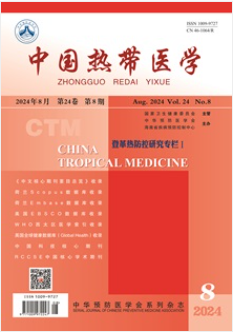不同新型冠状病毒核酸检测结果分析
引用次数: 0
摘要
目的了解2019冠状病毒病(COVID-19)不同类型和阶段标本中SARS-CoV-2核酸检测结果及其影响因素。方法采集桂林市新型冠状病毒肺炎疑似病例和密切接触者的深咳痰、咽拭子、粪便和结膜拭子样本。采用双荧光实时RT-PCR检测SARS-CoV-2 rna。收集流行病学、临床诊断和实验室资料,分析提高核酸检测灵敏度的因素。结果537例疑似病例及密切接触者共检出654份样本,其中深咳痰569份,咽拭子26份,粪便28份,结膜拭子31份。检出SARS-CoV-2核酸阳性32例,核酸阳性率为6.00%(32/537)。首次核酸阳性深咳痰取样时间自发病日起的中位天数(范围)为0 ~ 23天。深咳痰中SARS-CoV-2核酸阳性率显著高于咽拭子(P =0.000)。粪便和结膜拭子SARS-CoV-2核酸阳性例数分别为19例和5例,其采样时间平均比首次采样深咳痰SARS-CoV-2阳性的时间晚7 d。在32例新冠肺炎确诊病例中,有28例采集了单份SARS-CoV-2核酸阳性的深咳痰标本,其中在第1天、第2天、第3天、第4天、第5天及以上采集的标本分别为6例、6例、3例、4例和9例。4例深咳痰需采集2次及以上核酸阳性。采样前,1例有发热和治疗史。密切接触者于发病后第21天和第23天采集深咳痰2份,分别呈SARS-CoV-2核酸阴性和阳性。结论深咳痰比咽拭子对SARS-CoV-2核酸的检测效果更好,粪便和结膜拭子也能检测出SARS-CoV-2核酸阳性。采样类型、采样时间和治疗史是影响SARS-CoV-2核酸检测灵敏度的因素。为避免漏检,应对疑似病例或密切接触者进行隔离观察和多次抽样检测。摘要:目的了解不同类型和疾病进展阶段新型冠状病毒肺炎(2019年冠状病毒病,COVID-19)病例的标本新型冠状病毒(SARS-CoV-2)核酸检测结果及影响因素。方法对桂林市新型冠状病毒肺炎疑似病例及密切接触者分别采集深咳痰液,咽拭子,粪便及眼结膜拭子,采用双重实时荧光rt - pcr方法进行SARS-CoV-2核酸检测,收集流行病学,临床实验室及辅助诊断等资料,分析提髙核酸检测敏感性的因素。结果共采集537例COVID-19疑似病例及密切接触者标本654份,其中,深咳痰液569份咽拭子26份,粪便28份,眼结膜拭子31份。SARS-CoV-2核酸阳性32例,核酸阳性检出率6.00%(32/537);首次核酸阳性的深咳痰液的采样时间与发病时间的间隔天数0 ~ 23 d。在2种样本检测比较中、深咳痰液中SARS-CoV-2核酸阳性检出率明显髙于咽拭子标本的检出率(P = 0.000)。粪便和眼结膜拭子中SARS-CoV-2核酸阳性分别有19例和5例,它们的采样时间与首次核酸阳性的深咳痰液样本的采样时间比较平均晚7 d。在32例新型冠状病毒肺炎确诊病例中,28例单次采集深咳痰液样本为核酸阳性,其中,于发病第1、2、3和5 d及以上分别有6、6、3、4和9例;4例病例需采集2次及以上深咳痰液样本才出现核酸阳性结果。1例病例在采样前有发 热及治疗史,作为密切接触者排査隔离观察,分别于发病后第21天(阴性)、第23天(阳性)采集2份深咳痰液标本检测。 结论SARS-CoV-2核酸检测中深咳痰液标本优于咽拭子标本,粪便和眼结膜拭子也可检测到病毒核酸,采样方式,采样时机及治疗史为核酸检测敏感性的影响因素,对疑似病例或密切接触者需隔离观察并多次采样检测,以免漏检。本文章由计算机程序翻译,如有差异,请以英文原文为准。
Nucleic acid detection results analysis in different COVID-19 samples
Objective To understand the results and influencing factors of SARS-CoV-2 nucleic acid detection among specimens in different types and stages of coronavirus disease 2019 (COVID-19) progression. Methods The samples of deep-tussive sputum, pharyngeal swab, stool and conjunctival swab were collected among the suspected cases and close contacts of COVID-19 in Guilin. The SARS-CoV-2 RNAs were detected using double fluorescence real-time RT-PCR. The epidemiology, clinical diagnosis and laboratory data were collected to analyze the factors of improving the sensitivity of nucleic acid detection. Results A total of 654 samples were collected among 537 suspected cases and close contacts, including 569 deep-tussive sputum, 26 pharyngeal swabs, 28 stool and 31 conjunctival swabs. Thirty-two SARS-CoV-2 nucleic acid positive cases were found, with a nucleic acid positive rate of 6.00% (32/537). The median days (range) of the first nucleic acid positive deep-tussive sputum sampling time from onset day of illness were 0-23 days. The SARS-CoV-2 nucleic acid positive rate of deep-tussive sputum was significantly higher than that of pharyngeal swabs ( P =0.000). The SARS-CoV-2 nucleic acid positive number of stool and conjunctival swabs were 19 cases and 5 cases, respectively, which their sampling time were the average 7 days later than that of the first sampling deep-tussive sputum with SARS-CoV-2 positive. Among the 32 confirmed cases of COVID-19, there were 28 cases collected a single sample of deep-tussive sputum with SARS-CoV-2 nucleic acid positive, which samples of 6 cases, 6 cases, 3 cases, 4 cases and 9 cases were collected on the first day, 2nd day, 3rd day, 4th day, 5th day and above, respectively. In 4 cases, samples of deep-tussive sputum should be collected twice or more before nucleic acid positive results. Before sampling, one case had a history of fever and treatment. As a close contact, two samples of deep-tussive sputum were collected on the 21st day and 23rd day from onset day of illness, with SARS-CoV-2 nucleic acid negative and positive, respectively. Conclusions The deep-tussive sputum is better than pharyngeal swab in the detection of SARS-CoV-2 nucleic acid, and the SARS-CoV-2 nucleic acid positive can also be detected by stool and conjunctival swab. The sampling type, sampling time and treatment history are the influencing factors of the sensitivity of SARS-CoV-2 nucleic acid detection. So as not to miss detection, suspected cases or close contacts should be isolated observation and multiple sampling detection. 摘要:目的 了解不同类型和疾病进展阶段新型冠状病毒肺炎(coronavirus disease 2019,COVID-19)病例的标本新 型冠状病毒(SARS-CoV-2)核酸检测结果及影响因素。 方法 对桂林市新型冠状病毒肺炎疑似病例及密切接触者分 别采集深咳痰液、咽拭子、粪便及眼结膜拭子,采用双重实时荧光RT-PCR方法进行SARS-CoV-2核酸检测,收集流行 病学、临床实验室及辅助诊断等资料,分析提髙核酸检测敏感性的因素。 结果 共采集537例COVID-19疑似病例及 密切接触者标本654份,其中,深咳痰液569份,咽拭子26份,粪便28份,眼结膜拭子31份。SARS-CoV-2核酸阳性32 例,核酸阳性检出率6.00%(32/537);首次核酸阳性的深咳痰液的采样时间与发病时间的间隔天数0〜23 d。在2种样本 检测比较中,深咳痰液中SARS-CoV-2核酸阳性检出率明显髙于咽拭子标本的检出率( P =0.000)。粪便和眼结膜拭子 中SARS-CoV-2核酸阳性分别有19例和5例,它们的采样时间与首次核酸阳性的深咳痰液样本的采样时间比较平均 晚7 d。在32例新型冠状病毒肺炎确诊病例中,28例单次采集深咳痰液样本为核酸阳性,其中,于发病第1、2、3、和5 d 及以上分别有6、6、3、4和9例;4例病例需采集2次及以上深咳痰液样本才出现核酸阳性结果。1例病例在采样前有发 热及治疗史,作为密切接触者排査隔离观察,分别于发病后第21天(阴性)、第23天(阳性)采集2份深咳痰液标本检测。 结论 SARS-CoV-2核酸检测中深咳痰液标本优于咽拭子标本,粪便和眼结膜拭子也可检测到病毒核酸,采样方式、采 样时机及治疗史为核酸检测敏感性的影响因素,对疑似病例或密切接触者需隔离观察并多次采样检测,以免漏检。
求助全文
通过发布文献求助,成功后即可免费获取论文全文。
去求助
来源期刊
CiteScore
0.60
自引率
0.00%
发文量
13927
期刊介绍:
China Tropical Medicine, was approved by the Ministry of Science and Technology in 2001, is the only tropical medicine periodical under the charge of the National Health Commission of China. It’s organized by Hainan Provincial Center for Disease Prevention and Control, and Chinese Preventive Medicine Association.
The journal is indexed by the following database: Scopus database, Embase database, EBSCO Database, The Western Pacific Region index medicus (WPRIM), American Chemical Abstracts (CA), International Centre for Agricultural and Biological Sciences Research Database (CABI), Global Health Database, Database of the Ulrich's Periodicals Directory, China Science and Technology Core Journals, China Core Journals (Selection) Database, Database of Chinese Biomedical Literature, Comprehensive Evaluation Database of Chinese Academic Journals, CAJCD Code of Conduct Excellent Journal, Database of Chinese SCI-Tech Periodicals, China Journal Full Text Database.

 求助内容:
求助内容: 应助结果提醒方式:
应助结果提醒方式:


